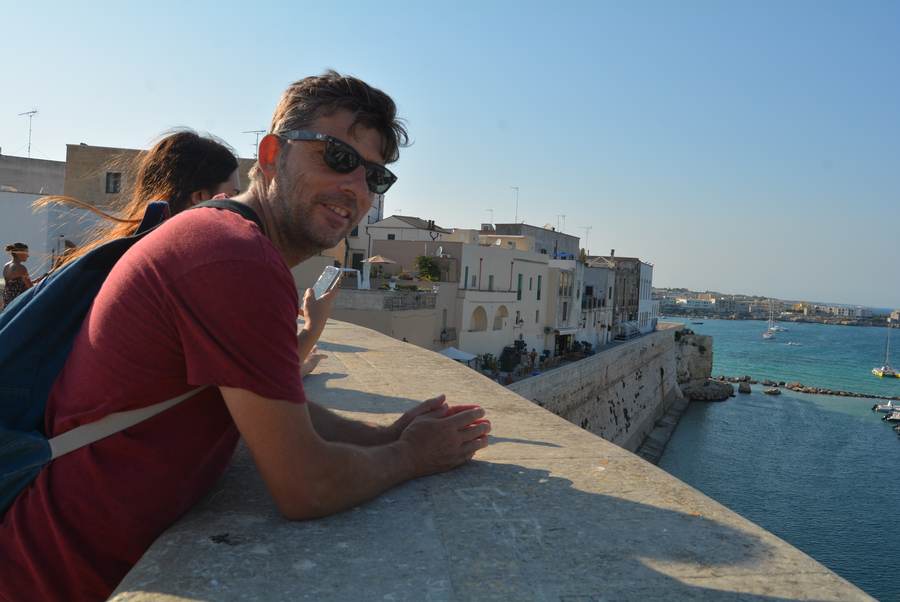Apulia - The undiscovered Heel of Italy
Our family vacation took us to Apulia in September 2017 where we rented two different villas and discovered another Italian region rich in history, sun and great laid back lifestyle. This is a region where Italians vacation and English-speaking tourists are still a novelty. It’s the southern region of Apulia, Puglia to Italians, at the heel end of Italy’s designer boot—the birthplace of rustic Italian cuisine famous chefs and diners adore. We’ll give you the lay of the land, talk about getting there and when to go, recommend some unique sights and villages to visit, and then focus on the cuisine of this exciting region.
Beautiful coastline and villages
Apulia is a striking peninsula consisting of nearly 500 miles of coastline with dramatic layered limestone cliffs, coves, sea caves and sea stacks, sun-baked coastal villages with fortressed castles, and expanses of sand and pebble beaches contrasted by the turquoise Adriatic and Ionian seas.
The landscape of its northeastern edge is forested highland with olives, grapes, and citrus groves extending down from the rocky hills. The interior is a flat, arid expanse known as the Murge plateau, with a panorama of fertile farmland where durum wheat for pasta and as much as 40% of Italy’s olive oil are cultivated.
Mix of Greek and Roman influence
The eclectic sights of human achievement are dazzling with Greek and Roman ruins, medieval castles, Renaissance cathedrals and shrines, and the unusual cone-shaped peasant homes in one village juxtaposed by the elaborate Baroque architecture of another. You’ll also see caves and prehistoric villages early people excavated that will make you swear you’re in biblical times.
Ideal for outdoors activities
Aside from the cultural stimulation afforded here, you can also enjoy the landscape from a bike, horse or hiking trail, lounge on a beach after a dip in the sea, or explore by kayak or sailboat. Use your Italian phrase book with the friendly locals and relax into the old-world atmosphere that is centered on enjoying the day and anticipating the next great meal!
Easy to travel to and get around
Apulia’s two airports are in the towns of Bari on its southeastern coast, and Brindisi about 70 miles further almost to its southeastern tip. Flights from the U.S. are available but expensive and will include one or more stops depending on your originating city. We suggest you consider approaching Apulia from Rome and hop a quick one hour flight instead.
If you prefer to travel by train, Rome to Foggia in Apulia’s northeast section will take three to five hours depending on the type of train you take. Once in Foggia, you can reach Lecce at the southern tip in just over two hours on a speedy Eurostar train or four hours by regular train. The larger cities are connected by train and bus routes so you could use public transportation to see the central sites in each one.
However, if you really want to immerse yourself in this fascinating area it’s best to rent a car so you’re not limited to only the sights and beaches near the transportation hubs.
FIND YOUR VILLA RENTAL IN PUGLIA NOW!!
Villa di Foroque , Santa Maria di Leuca
Shoulder season: always the best time to travel
I’ll just say it: it’s hotter than the hinges of hell in Apulia in the summer, particuIlarly in August when the temperature can reach the upper 90s and beyond. The soluble limestone, which comprises much of the area, heats up like a pizza stone in the sun and absorbs the infrequent rain making it quite dry here. However, with the sea nearby and gelato in every town, you’ll have no trouble cooling off as you tour this amazing part of Italy.
Crowds also peak in August, as in many parts of Europe, so if you can travel during the shoulder seasons of spring and fall you’ll be rewarded with lower temperatures and fewer shoulders to bump up against.
Martina Franca
Must-see towns and areas
Here are a few places that are representative of the interesting variety in Apulia’s landscape and architecture, and ones we think you’ll enjoy visiting.
Lecce:
Called “The Florence of the South”, Lecce is famous for its elaborate Baroque architecture. Here, the indigenous soft stone has been transformed into a sea of villas, piazzas, and dozens of churches with intricately carved façades decorated with statuary, biblical scenes, and other embellishments. See the lovely Basilica di Santa Croce while you’re here, and the ruins of a 2nd century 15,000 seat Roman amphitheatre below Piazza Sant’Oronzo that peeks out from the surrounding decorative buildings.
Lecce is a relaxed place for savoring life and a real party during the festival La Notte Bianca (White Night), when no one sleeps and museums, art exhibits, and music are enjoyed all night.
Taking in the breathtaking view in Gallipoli
Otranto:
Anchored at the southeastern tip of Apulia on the Salento Peninsula, is this lovely coastal village of whitewashed walls that glow against the sea’s blue backdrop. Once Italy’s primary port to Asia and thus coveted by the Turks and others, Otranto’s historic center was fortressed for protection but now safeguards a pedestrian-only zone where you can meander through shops and linger in cafes along its narrow streets.
See the elaborate mosaic floor of the 12th century Cathedral of Santa Maria Annunziata. The intricately detailed Tree of Life hints at Apulia’s foreign rule in its the Norman, Greek, and Byzantine feel.
Otranto is also a great place to play in the sea with mile after gorgeous mile of beach area. Retreat to one of the oceanfront restaurants for the fresh catch of the day which may include sea bass, red mullet, shellfish, and octopus dishes.
Villa Baronale, Sava Taranto
Gargano Promontory:
Located in the northeast region, the Gargano is Apulia’s “mountainous” area with sun-bleached cliffs rising to 3,000 ft. This densely forested section has terrain unlike anywhere else on the peninsula with pine forests and several varieties of orchids.
Along the shore, the medieval villages of Vieste and Peschici, beckon many with their popular beaches. Gaze up and you’ll see watchtowers on the cliffs above; cast your gaze around and you may see fisherman preparing their trabucchi (a type of traditional fishing net) on the docks.
Above the village of Mont Sant Angelo in this region, stands the San Michele Pilgrimage Shrine. One of the most interesting elements of the shrine is its cave sanctuary—Archangel Michael Sanctuary—which was carved like a sculpture from the rock face in this setting.
Finally, you can explore the natural surroundings on hiking the trails in the national park, Parco Nazionale del Gargano. Just over the hill from the park, olive and citrus groves blanket the down slopes and perfume the springtime air.
While it’s common to see elaborate Renaissance and Baroque architecture and even Greek ruins in Italy, it’s unusual to come upon evidence of structures before medieval times which is what makes these next sights so intriguing.

Trulli
Trulli (plural of trullo) are cylindrical one-room structures with thick stone walls and cone-shaped stone roofs that are seen nowhere else in the world. They were historically built as temporary peasant homes and storehouses, and as such it was forbidden to reinforce them with mortar. It’s unclear why the edict of temporary building was decreed, but it seems inconsequential now since they’re still standing some 300 years later and designated a UNESCO world heritage site.
The largest concentration of trulli is in the village of Alberobello in the Itria Valley of the Bari province, although you’ll see them accent the landscape from Putignano to Martina Franca. Many private trullo have been renovated and modernized to make memorable guest housing, such as RentaVilla’s luxurious Villa Fatugal, and the lovely Lizzaro Trullo Estate.
FIND YOUR VILLA RENTAL IN APULIA NOW!!
Sassi di Matera
The Matera’s district of primitive sassi dwellings are thought to be the oldest human settlement in Italy dating back about 9,000 years. Like the troglodyte “houses” in central France, caverns were dug from the abundant calcareous rock and inhabited by early peoples. If you’ve seen the films, “The Passion of the Christ”, or “The Nativity Story”, you’ve seen the Apulian village Matera which served as these films’ “Jerusalem” since it so closely resembles this sacred ancient area. It’s worth a trip to this unusual grouping of early homes to see these humble beginnings, especially after you’ve taken in the splendor at Lecce.
Villa in Itria Valley near Cisterino we stayed at
Fresh products abound
Sunny Apulia has the perfect growing climate for a huge variety of produce, such as wheat, grapes, olives, almonds, figs, garlic, onions, nightshades (tomatoes, peppers, and eggplant), artichokes, zucchini, peaches, and watermelon. It’s Italy’s farm-stand. Sheep and cows are also tended here which means you will find burrata, mozzarella, and ricotta to go with all that produce and bread, as well as cuts of meat.
Apulians are passionate about their cuisine which is a combination of taste, art, and cultural pride and celebrated in dedicated food fairs (sagre) on multiple days in literally every calendar month.
Come to Foggia in February and you can partake in the Feta della Pignata, the Octopus Festival. Or, if you’re here in Crispiano come mid-July you can sample the liver, snails, bread, and gelato that are featured in a combined sagra.
For the purchase of a ticket you can go from stand to stand tasting different takes on the featured ingredient—peaches done 12 ways. Wine is always a featured ingredient so expect to have your glass continuously filled as you sample your way through. Festivals draw musicians so you’ll likely hear the Taranta (local folk music) wafting from an accordion, or melodies from a scheduled concert in the air.

Cuisine
Rustic Italian cuisine is often associated with heavy dishes like maccheroni al forno, which is a savory pie consisting of pasta, meatballs and hard-boiled eggs. Yet, there is also lighter fare represented in a variety of fresh vegetarian dishes—orecchiette (dainty ear-shaped pasta) with mushrooms or turnip greens, and the traditional purè di fave (a puree of fava beans and potatoes with olive oil)—as well as seafood—spicy cured tuna called Tarantello, and zuppa di pesce (fish soup) to name two of the many.
If you enjoy cooking, forget the souvenirs and take one of the numerous cooking classes offered in this area instead. Here’s a year-round southern Italian cooking school based in Lecce to get you started: awaitingtable.com Not a cook? No worries! You can always collect memories of wonderful tastes as souvenirs…
Wine
The grapes grown in this region have made not only Italian wines; the bold Negroamaro (“black bitter") grapes have been a secret ingredient in wines all over Europe, fortifying their vintages in years when their own grape production was low. Apulia is the largest wine producing area in Italy, capturing nearly 17% of its market, which is primarily red wines. Try the Salice Salentino or Primitivo di Manduria, both full-bodied reds featured on most menus and generously poured during sagre events.
Palazzo in Salento region we stayed at
One last idea about Apulia: If you plan a trip to southern Italy for August, try to experience the Sagra Pirotecnica della Valle d’Itria festival in Locorotondo. Specifically, a spectacular fireworks competition takes place between a number of pyrotechnic experts during this five day party to honor Locorotondo’s patron saint, San Rocco. Information on the 2013 event isn’t yet out, so if you’re interested check online for more information.










